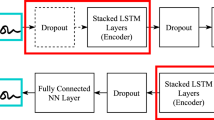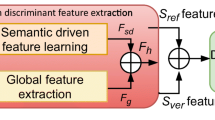Abstract
Writer identification is the task of specifying the genuine writer according to their handwriting across a set of enrolled subjects which is a noteworthy research topic in the community of document analysis and recognition. In this paper, a novel framework based totally on identity vector is introduced for the online writer identification task. In the proposed framework, the sequence of extracted feature vectors from each handwriting sample is embedded into a fixed-length vector, referred to as identity vector (i-vector), to capture the long-term sequence-level writer-related characteristics, and then passed to the next stage for classification. Several techniques for feature normalization and intra-class variation reduction techniques in the i-vector domain such as within-class covariance normalization and regularized linear discriminant analysis are also investigated. We extensively evaluate the introduced framework on the popular database, CAISA, for English and Chinese language in various scenarios, such as multi-language and cross-language. Experimental results show, in the best cases, the proposed framework could achieve 98.68% accuracy on English dataset and 96.03% on Chinese dataset of the CAISA database. These obtained results indicate an improvement over the best reported result of the current state-of-the-art approaches with the exception of fully end-to-end approaches which have their own serious limitation in the real applications. In addition to the accuracy improvement, due to its low computational load it has the potential to be implemented on the handheld digital devices.






Similar content being viewed by others
Explore related subjects
Discover the latest articles, news and stories from top researchers in related subjects.References
Bertolini D, Oliveira LS, Justino E, Sabourin R (2013) Texture-based descriptors for writer identification and verification. Expert Syst Appl 40(6):2069–2080
Bulacu M, Schomaker L (2007) Text-independent writer identification and verification using textural and allographic features. IEEE Trans Pattern Anal Mach Intell 29(4):701–717
Chaabouni A, Boubaker H, Kherallah M, Alimi AM, El Abed H (2011) Multi-fractal modeling for on-line text-independent writer identification. In: 2011 international conference on document analysis and recognition. IEEE, pp 623–627
Chan SK, Tay YH, Viard-Gaudin C (2007) Online text independent writer identification using character prototypes distribution, in: 2007 6th International Conference on Information, Communications & Signal Processing, IEEE, pp. 1–5
Chen L, Yang Y (2011) Applying emotional factor analysis and i-vector to emotional speaker recognition. In: Chinese conference on biometric recognition. Springer, pp 174–179
Dehak N, Kenny PJ, Dehak R, Dumouchel P, Ouellet P (2010) Front-end factor analysis for speaker verification. IEEE Trans Audio Speech Lang Process 19(4):788–798
Dhieb T, Njah S, Boubaker H, Ouarda W, Ayed MB, Alimi AM n online writer identification system based on beta-elliptic model and fuzzy elementary perceptual codes. CoRR
Dhieb T, Ouarda W, Boubaker H, Alimi AM (2016) Deep neural network for online writer identification using beta-elliptic model. In: 2016 International joint conference on neural networks (IJCNN). IEEE, pp 1863–1870
Dhieb T, Ouarda W, Boubaker H, Halima MB, Alimi AM (2015) Online Arabic writer identification based on beta-elliptic model. In: 2015 15th international conference on intelligent systems design and applications (ISDA). IEEE, pp 74–79
Eghbal-Zadeh H, Lehner B, Schedl M, Widmer G (2015) I-vectors for timbre-based music similarity and music artist classification. In: ISMIR, pp 554–560
Friedman JH (1989) Regularized discriminant analysis. J Am Stat Assoc 84(405):165–175
Gargouri M, Kanoun S, Ogier JM (2013) Text-independent writer identification on online Arabic handwriting. In: 2013 12th international conference on document analysis and recognition. IEEE, pp 428–432
Glembek O, Burget L, Matějka P, Karafiát M, Kenny P (2011) Simplification and optimization of i-vector extraction. In: 2011 IEEE international conference on acoustics, speech and signal processing (ICASSP). IEEE, pp 4516–4519
Hatch AO, Kajarekar S, Stolcke A (2006) Within-class covariance normalization for SVM-based speaker recognition, in: Ninth international conference on spoken language processing
Jain AK, Ross AA, Nandakumar K (2011) Introduction to biometrics. Springer, New York
Kenny P, Boulianne G, Dumouchel P (2005) Eigenvoice modeling with sparse training data. IEEE Trans Speech Audio Process 13(3):345–354
Li B, Sun Z, Tan T (2009) Hierarchical shape primitive features for online text-independent writer identification. In: 2009 10th international conference on document analysis and recognition. IEEE, pp 986–990
Liwicki M, Schlapbach A, Bunke H, Bengio S, Mariéthoz J, Richiardi J (2006) Writer identification for smart meeting room systems. In: International workshop on document analysis systems. Springer, pp 186–195
Martinez D, Plchot O, Burget L, Glembek O, Matějka P (2011) Language recognition in ivectors space. In: Twelfth annual conference of the international speech communication association
McLachlan G (2004) Discriminant analysis and statistical pattern recognition, vol 544. Wiley, New York
Nicolaou A, Bagdanov AD, Liwicki M, Karatzas D (2015) Sparse radial sampling LBP for writer identification. In: 2015 13th international conference on document analysis and recognition (ICDAR). IEEE, pp 716–720
Njah S, Ltaief M, Bezine H, Alimi AM (2012) The pertohs theory for on-line handwriting segmentation. Int J Comput Sci Issues (IJCSI) 9(5):142
Schlapbach A, Liwicki M, Bunke H (2008) A writer identification system for on-line whiteboard data. Pattern Recogn 41(7):2381–2397
Shivram A, Ramaiah C, Govindaraju V (2013) A hierarchical Bayesian approach to online writer identification. IET Biom 2(4):191–198
Siddiqi I, Vincent N (2010) Text independent writer recognition using redundant writing patterns with contour-based orientation and curvature features. Pattern Recogn 43(11):3853–3865
Singh G, Sundaram S (2015) A subtractive clustering scheme for text-independent online writer identification. In: 2015 13th international conference on document analysis and recognition (ICDAR). IEEE, pp 311–315
Soufifar M, Kockmann M, Burget L, Plchot O, Glembek O, Svendsen T (2011) ivector approach to phonotactic language recognition. In: Twelfth annual conference of the international speech communication association
Tan GX, Viard-Gaudin C, Kot AC (2008) A stochastic nearest neighbor character prototype approach for online writer identification. In: 2008 19th international conference on pattern recognition, IEEE, pp 1–4
Tan GX, Viard-Gaudin C, Kot AC (2009) Automatic writer identification framework for online handwritten documents using character prototypes. Pattern Recogn 42(12):3313–3323
Venugopal V, Sundaram S (2017) An online writer identification system using regression-based feature normalization and codebook descriptors. Expert Syst Appl 72:196–206
Venugopal V, Sundaram S (2018) An improved online writer identification framework using codebook descriptors. Pattern Recogn 78:318–330
Wei X, Wenju L et al (2017) Multilingual i-vector based statistical modeling for music genre classification
Xia R, Liu Y (2012) Using i-vector space model for emotion recognition. In: Thirteenth annual conference of the international speech communication association
Yang W, Jin L, Liu M (2016) Deepwriterid: an end-to-end online text-independent writer identification system. IEEE Intell Syst 31(2):45–53
Zeinali H, BabaAli B, Hadian H (2017) Online signature verification using i-vector representation. IET Biometrics 7(5):405–414
Zeinali H, Sameti H, Burget L (2017) Hmm-based phrase-independent i-vector extractor for text-dependent speaker verification. IEEE/ACM Trans Audio Speech Lang Process 25(7):1421–1435
Zeinali H, BabaAli B (2017) On the usage of i-vector representation for online handwritten signature verification. In: 2017 14th IAPR international conference on document analysis and recognition (ICDAR), vol 1. IEEE, pp 1243–1248
Zhang X-Y, Xie G-S, Liu C-L, Bengio Y (2016) End-to-end online writer identification with recurrent neural network. IEEE Trans Hum Machine Syst 47(2):285–292
Acknowledgements
The author would like to thank Professor Patrick Wambacq from KU Leuven for his valuable scientific discussion that has contributed to improve the quality of this work.
Author information
Authors and Affiliations
Contributions
This article has one author (Bagher BabaAli), and all aspects of it have been covered by him.
Corresponding author
Ethics declarations
Conflicts of interest
The author declares that he has no conflict of interest.
Additional information
Publisher's Note
Springer Nature remains neutral with regard to jurisdictional claims in published maps and institutional affiliations.
Rights and permissions
About this article
Cite this article
BabaAli, B. Online writer identification using statistical modeling-based feature embedding. Soft Comput 25, 9639–9649 (2021). https://doi.org/10.1007/s00500-021-05729-x
Accepted:
Published:
Issue Date:
DOI: https://doi.org/10.1007/s00500-021-05729-x




